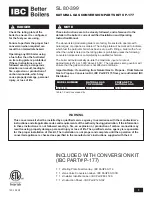
PRE-INSTALLATION
6 720 803 800 (2012/11)
10
USE IN HARD WATER AREAS:
Normally there is no need for water treatment to prevent scale formation
as the maximum temperature of the DHW heat exchanger is limited by
the electronic control.
In areas where temporary water hardness exceeds 200 ppm,
consideration may need to be given to the fitting of a scale prevention
device. In such circumstances, the advice of the local water authority
should be sought.
3.3
WATER SYSTEMS AND PIPE WORK
PLASTIC PIPE WORK:
• Any plastic pipe work must have a polymeric barrier with 600mm
(minimum) length of copper pipe before being connected to the
boiler.
• Plastic pipe work used for underfloor heating must be correctly
controlled with a thermostatic blending valve limiting the temperature
of the circuits to approximately 50°C.
PRIMARY SYSTEMS CONNECTIONS/VALVES:
• All system connections, taps and mixing valves must be capable of
sustaining a pressure up to 3 bar.
• Radiator valves should conform to BS2767:10.
• All other valves should conform to BS1010.
• Thermostatic radiator valves (TRV’s) must be fitted to all rooms
except bathrooms and the room in which the room thermostat is
fitted.
• A drain cock is required at the lowest point(s) in the system.
• An air vent is required at the high point(s) in the system.
SHOWERS/BIDETS:
• If a shower head can be immersed in water or comes closer than
25mm from the top edge of a bath or shower tray spill over level then
an anti-siphon device must be fitted to the shower hose.
• Bidets with direct hot and cold mains water can be used (with the
approval of the local water authority) and must be the over rim
flushing type with shrouded outlets to prevent the fitting of hand held
sprays.
SEALED PRIMARY SYSTEM:
• The CH sealed system must be filled using a WRAS approved filling
loop or comply with figure 2 for system fill.
• Where the system volume is more than 100 litres or exceeds 2.65 bar
at maximum heating temperature, an extra expansion vessel (2) must
be fitted as close as possible to the appliance in the central heating
return.
• Pressurise the extra expansion vessel (2) to the same figure as the
expansion vessel built into the appliance, (approximately 0.75 bar).
•
Do not use galvanised pipes or radiators
.
SYSTEM FILL
Fig. 2
System fill
TYPICAL SEALED SYSTEM
Fig. 3
Sealed system
Fig. 4
Sealed system with zone valves
1
Mini expansion vessel - part no. 7 716 192 105
2
Mains water inlet pipe
3
Non return valve
4
Boiler
The boiler is equipped with an internal by-pass.
The internal bypass is not intended to be a substitute for
an external system bypass.
An external automatic bypass should be used if the
system flow can be significantly adjusted or stopped by
zone valves and thermostatic radiator valves (TRV).
1
4
3
2
6720643895-04.1Wo
NOTICE:
Artificially softened water must not be used to
fill the central heating system.
1
Appliance expansion vessel - CH
2
Extra expansion vessel - CH return
3
Pressure relief discharge
4
Drain cock
5
Radiators
6
Zone valves
Table 6 Key to figs. 3 and 4
CV = Check Valve
SV = Stop Valve
SV
SV
Test point
Temporary hose
Hose union
CV
CV
Heating
return
Mains
supply
4
4
1
2
3
5
5
5
5
6720643895-06.1Wo
4
6
4
2
3
5
5
5
5
M
M
6720646608-04.1W
o
1











































